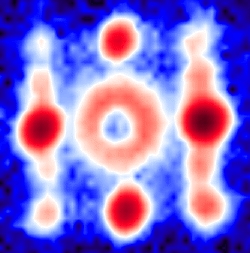Windows on the Superconducting Soul

Vortices normally repel one another and form a fixed triangular lattice that increases in density as the magnetic field is turned up. With the discovery of high- superconductors, researchers observed a range of new vortex phenomena, such as vortex lattices that move, change shape, and even “melt” into a “vortex liquid.” These can all affect superconducting devices, and in recent years, vortex physicists have gone back to lower temperature superconductors to look for similar phenomena and a better understanding of them.
Thierry Klein, of the French National Center for Scientific Research in Grenoble, and his colleagues imaged the vortex lattice of using the diffraction of a neutron beam, which reveals vortex locations in essentially the same way that x rays give the positions of atoms in crystals. As they increased the magnetic field on the sample, the neutron signal dropped, reaching zero at a field of about 0.6 T. The team interprets their data as signifying a transition to a state where the vortices become entangled like spaghetti when they get close enough to interact strongly. The entangled state has been proposed in some better-known high- materials, but this is the first clear demonstration of it, thanks to some special properties of the material, such as the cubic symmetry of the crystal. The layered structure of most high- materials makes vortex phase transitions more difficult to observe and interpret.
Mohana Yethiraj, of the Oak Ridge National Laboratory in Tennessee, and her colleagues used the same technique to look at vortices in another cubic crystal: The phase transition they observed at a 1 T magnetic field was from the usual triangular vortex lattice to a square lattice. Although such a transition has been seen in other materials, this team was able to rotate the sample to clearly see the effects of applying the field in several different directions. The transition occurs when the vortices interact anisotropically–rather than repelling one another uniformly in all directions, the inter-vortex forces depend on direction in a way that is determined by the structure of the crystal.
Team member David Christen explains that the transition, which was predicted for by recent theoretical work, reflects the anisotropic interactions of the superconducting electrons with the crystal and the magnetic field. “The structure of the vortex lattice is a very sensitive indicator” of these interactions, he says, compared with other types of experiments on superconductors, such as measuring resistance.
The two sets of experiments are good examples of using the vortex structure to learn about superconductors, according to Peter Gammel of Lucent Technologies in Murray Hill, NJ. Although they address different issues, he says both teams are “probing new ground” by using cubic crystals to study phenomena first seen in the layered high- materials.


